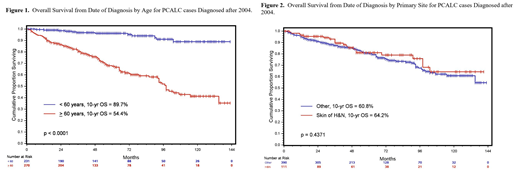Introduction
Primary cutaneous anaplastic large-cell lymphoma (PCALCL) is a rare T-cell lymphoma that presents as a solitary or grouped nodules. It is characterized by anaplastic-appearing cells that are usually ALK negative but have high expression of CD30. There is paucity of epidemiologic data on PCALCL. A prior analysis of the Surveillance, Epidemiology, and End Results (SEER) database by Yu et al. reported only 157 cases from 1973 to 2004. We are presenting an analysis of the patients diagnosed with PCALCL after 2004.
Methods
We used the SEER database to retrospectively identify patients diagnosed with PCALCL from 2005 to 2016. The database collects data from cancer registries covering approximately 26% of the US population and was used to estimate frequencies and overall incidence rate. Survival was analyzed using the Kaplan-Meier method and log-rank tests were used to compare survival distributions. We assessed the effect of primary skin site (head and neck) and increasing age on survival as they were suggestive of decreased overall survival on multivariate analysis of the 1973-2004 cohort. P < 0.05 was considered statistically significant for all analysis.
Results
There were 501 cases of PCALCL recorded from 2005 to 2016. Median follow-up was 52 months. The overall incidence rate was found to be 0.12/1,000,000 age adjusted to the 2000 US standard population. More than 50% of the cases were diagnosed after 2010. The median age at diagnosis was 61 years (2-97 years). It was seen most frequently in White (72.9%) patients followed by Hispanic (10.2%) and Black (9.4%) patients. The male to female ratio was 1.42. The most common primary sites affected were the skin of the lower limbs and hip (26.4%) and head and neck (21.3%). A 33.4% of patients required treatment which was mainly excisional (1 patient required amputation). Notably, PCALCL was diagnosed as a second or third malignancy in 19.2% of cases.
Overall survival rates at 5 years and 10 years were found to be 80.6% (95% CI: 76.3%, 84.3%) and 61.5% (95% CI: 54.1%, 68.1%) respectively. Age greater than 60 years old was significantly associated with a lower survival (89.7% vs 54.4%, p<0.0001). Survival was not significantly different if head and neck was the site of the primary lesion (64.2% vs 60.8%, p = 0.4371).
Conclusion
Our analysis of the SEER database for PCALCL is the largest done to our knowledge. Although the number of cases has almost tripled since 2005, it is still a rare type of cutaneous T-cell lymphoma. Lower extremities and hips are the most frequent primary skin site. Only a third of the patients required treatment with overall survival rates of more than 80% by 5 years. Older age (more than 60 years old) is associated with a worse outcome. Head and neck as the primary skin site does not appear to be associated to lower survival as previously thought.
No relevant conflicts of interest to declare.
Author notes
Asterisk with author names denotes non-ASH members.


This feature is available to Subscribers Only
Sign In or Create an Account Close Modal